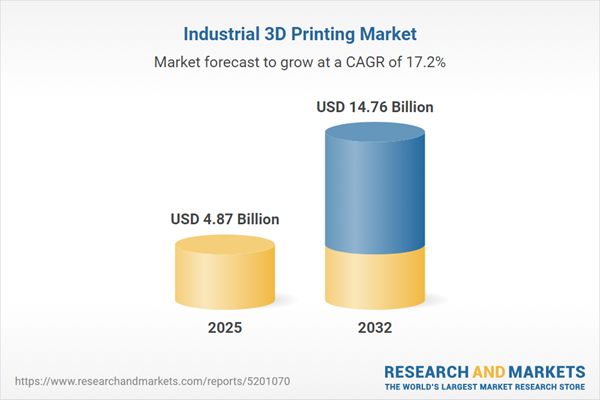Speak directly to the analyst to clarify any post sales queries you may have.
Industrial 3D printing is revolutionizing how enterprises approach manufacturing, facilitating innovation in design, production agility, and supply chain efficiency. As digital manufacturing becomes foundational to many sectors, business leaders are leveraging industrial 3D printing to drive strategic differentiation and operational improvements.
Market Snapshot: Industrial 3D Printing Market Size and Growth
The Industrial 3D Printing Market grew from USD 4.15 billion in 2024 to USD 4.87 billion in 2025. It is expected to continue growing at a CAGR of 17.16%, reaching USD 14.76 billion by 2032. This robust trajectory highlights sustained demand for advanced additive manufacturing in sectors seeking precise, rapid prototyping and on-demand production capabilities. Organizations are embracing these solutions to unlock new design flexibilities and accelerate time-to-market while optimizing costs and material use.
Scope & Segmentation of the Industrial 3D Printing Market
This report delivers an in-depth analysis across all critical segments, helping senior leaders identify focused growth opportunities and manage evolving complexities. Coverage includes:
- Technology: Binder Jetting (including Metal Binder Jetting and Sand Binder Jetting), Direct Energy Deposition, Material Extrusion, Material Jetting, Powder Bed Fusion, Vat Photopolymerization.
- Material Types: Ceramics, Composites, Metals, Polymers.
- Machine Types: Desktop, Industrial, Large Format.
- End User Industries: Aerospace & Defense, Automotive, Consumer Goods, Education & Research, Electronics, Healthcare & Medical, Industrial.
- Geographical Regions: Americas (North America: United States, Canada, Mexico; Latin America: Brazil, Argentina, Chile, Colombia, Peru), Europe, Middle East & Africa (Europe: United Kingdom, Germany, France, Russia, Italy, Spain, Netherlands, Sweden, Poland, Switzerland; Middle East: United Arab Emirates, Saudi Arabia, Qatar, Turkey, Israel; Africa: South Africa, Nigeria, Egypt, Kenya), Asia-Pacific (China, India, Japan, Australia, South Korea, Indonesia, Thailand, Malaysia, Singapore, Taiwan).
- Leading Providers: Stratasys Ltd., 3D Systems, Inc., EOS GmbH, HP Inc., General Electric Company, Materialise NV, SLM Solutions Group AG, Renishaw plc, Desktop Metal, Inc., Voxeljet AG.
Key Takeaways for Senior Decision-Makers
- Widespread industrial 3D printing adoption is reshaping product development cycles and enabling mass customization, especially in high-value engineering sectors.
- Technological advances in software integration, automated powder handling, and process monitoring are improving system efficiency and reducing lead times.
- Hybrid process configurations and emerging materials, such as heat-resistant ceramics and high-performance composites, are opening significant new application areas.
- Collaborations between technology providers, service bureaus, and research institutions drive innovation and lower operational barriers for enterprise adoption.
- Distinct machine classes—from desktop systems for education to large-format platforms for industrial parts—allow customization of additive solutions to match unique user requirements.
Tariff Impact: 2025 United States Measures
Recent tariff measures in the United States have resulted in increased sourcing and pricing challenges for select materials and components in industrial 3D printing. In response, organizations are establishing localized production hubs, forming new supplier partnerships, and adopting design optimization strategies to maintain cost efficiencies and minimize reliance on tariff-affected resources. Industry consortia are collaborating with regulatory bodies to advocate for certification pathway improvements and critical technology exemptions. This collective adaptability is crucial to preserving innovation while meeting shifting trade regulations.
Industrial 3D Printing Market Research Methodology
The report employs a balanced methodology, integrating in-depth primary interviews with manufacturing executives, material suppliers, and technology experts alongside rigorous analysis of secondary sources, including peer-reviewed journals, market studies, and patent filings. Data triangulation and validation workshops ensure insights are robust and grounded in industry realities.
Why This Report Matters
- Enables informed investment and operational decisions by providing actionable analysis across technologies, materials, and regions relevant to industrial 3D printing.
- Guides strategic planning by profiling market leaders, emerging players, and evolving segment opportunities for senior executives.
- Equips organizations to respond to regulatory, supply chain, and technology trends with practical strategies for resilience and growth.
Conclusion
Industrial 3D printing stands at a pivotal evolution point, offering new efficiencies and innovation potential for manufacturers worldwide. This report empowers senior leadership with the insights needed to navigate complexity, unlock value, and drive sustained competitive advantage.
Additional Product Information:
- Purchase of this report includes 1 year online access with quarterly updates.
- This report can be updated on request. Please contact our Customer Experience team using the Ask a Question widget on our website.
Table of Contents
3. Executive Summary
4. Market Overview
7. Cumulative Impact of Artificial Intelligence 2025
Companies Mentioned
The companies profiled in this Industrial 3D Printing market report include:- Stratasys Ltd.
- 3D Systems, Inc.
- EOS GmbH
- HP Inc.
- General Electric Company
- Materialise NV
- SLM Solutions Group AG
- Renishaw plc
- Desktop Metal, Inc.
- Voxeljet AG
Table Information
| Report Attribute | Details |
|---|---|
| No. of Pages | 198 |
| Published | October 2025 |
| Forecast Period | 2025 - 2032 |
| Estimated Market Value ( USD | $ 4.87 Billion |
| Forecasted Market Value ( USD | $ 14.76 Billion |
| Compound Annual Growth Rate | 17.1% |
| Regions Covered | Global |
| No. of Companies Mentioned | 11 |









